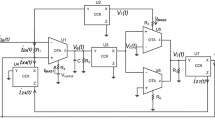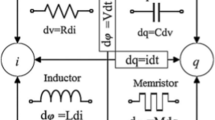Abstract
In this paper, a new floating analog memristance simulator circuit based on dual-output operational transconductance amplifiers (DO-OTA) and passive elements is proposed. Theoretical derivations are presented which describe the circuit characteristics. DO-OTA active elements in the proposed circuit are realized with CMOS transistors, and PSPICE simulations are performed. Also workability of the circuit is tested experimentally by using commercially available integrated circuits. Theoretical derivations are validated with PSPICE simulation and experimental results. All results show that proposed simulator circuit provides frequency-dependent pinched hysteresis loop and nonvolatility feature. Exciting frequency, minimum and maximum memristance values and memristance range can be adjustable electronically with bias currents by changing the transconductances of DO-OTAs. Simulator circuit has a frequency range of 1 Hz–180 kHz.














Similar content being viewed by others
References
M.T. Abuelmaatti, Z.J. Khalifa, A new floating memristor emulator and its application in frequency-to-voltage conversion. Analog Integr. Circuits Signal Process. 86(1), 141–147 (2016)
S.P. Adhikari, MPd Sah, H. Kim, Three fingerprints of memristor. IEEE Trans. Circuits Syst. I Regul. Pap. 60(11), 3008–3021 (2013)
A.G. Alharbi, M.E. Fouda, Z.J. Khalifa, M.H. Cowdhury, in 2016 IEEE 59th International Midwest Symposium on Simple Generic Memristor Emulator for Voltage-Controlled Models, Circuits and Systems (MWSCAS) (2016), pp. 1558–3899
A.G. Alharbi, M.E. Fouda, M.H. Cowdhury, A novel flux-controlled memristive emulator for analog applications, advances in memristors, memristive devices and systems. Stud. Comput. Intell. 701, 493–511 (2017)
A.G. Alharbi, M.E. Fouda, Z.J. Khalifa, M.H. Cowdhury, Electrical nonlinearity emulation technique for current-controlled memristive devices. IEEE Access 5, 5399–5409 (2017)
Z.G. Cam, H. Sedef, A new floating memristance simulator circuit based on second generation current conveyor. J. Circuits Syst. Comput. 26(2), 1750029 (2017)
L. Chua, Memristor—the missing circuit element. IEEE Trans. Circuit Theory 18(5), 507–519 (1971)
Y.N. Joglekar, S.J. Wolf, The elusive memristor: properties of basic electrical circuits. Eur. J. Phys. 30(4), 661–675 (2009)
K. Kaewdang, W. Surakampontorn, On the realization of electronically current-tunable CMOS OTA. AEU Int. J. Electron. Commun. 61, 300–306 (2007)
H. Kim, MPd Sah, C. Yang, S. Cho, L.O. Chua, Memristor emulator for memristor circuit applications. IEEE Trans. Circuits Syst. I Regul. Pap. 59(10), 2422–2431 (2012)
I. Koymen, E.M. Drakakis, in 14th International Workshop on CMOS-Based Nanopower Memristor Dynamics Emulator, Cellular Nanoscale Networks and Their Applications (CNNA) (2014)
V.H. Nguyen, K.Y. Sohn, H. Song, On-printed circuit board emulator with controllability of pinched hysteresis loop for nanoscale TiO2 thin-film memristor device. J. Comput. Electron. 15(3), 993–1002 (2016)
H. Sozen, U. Cam, Electronically tunable memristor emulator circuit. Analog Integr. Circuits Signal Process. 89(3), 655–663 (2016)
D.B. Strukov, G.S. Snider, D.R. Stewart, S.R. Williams, The missing memristor found. Nature 453(7191), 80–83 (2008)
Texas Instruments, LM13700 dual operational transconductance amplifiers with linearizing diodes and buffers. LM13700 datasheet, Rev. F. (2015)
Texas Instruments, Low cost analog multiplier. AD633 datasheet, Rev. K. (2016)
L. Wei, W. Fa-Qiang, M. Xi-Kui, Exponential flux-controlled memristor model and its floating emulator. Chin. Phys. B 24(11), 118401 (2015)
C. Yang, H. Choi, S. Park, M.P. Sah, H. Kim, L.O. Chua, A memristor emulator as a replacement of a real memristor. Semicond. Sci. Technol. 30(1), 015007 (2015)
C. Yener, H.H. Kuntman, Fully CMOS memristor based chaotic circuit. Radioengineering 23(4), 1140–1149 (2014)
A. Yesil, Y. Babacan, F. Kacar, A new DDCC based memristor emulator circuit and its applications. Microelectron. J. 45(3), 282–287 (2014)
Author information
Authors and Affiliations
Corresponding author
Rights and permissions
About this article
Cite this article
Cam Taskiran, Z.G., Ayten, U.E. & Sedef, H. Dual-Output Operational Transconductance Amplifier-Based Electronically Controllable Memristance Simulator Circuit. Circuits Syst Signal Process 38, 26–40 (2019). https://doi.org/10.1007/s00034-018-0856-y
Received:
Revised:
Accepted:
Published:
Issue Date:
DOI: https://doi.org/10.1007/s00034-018-0856-y




